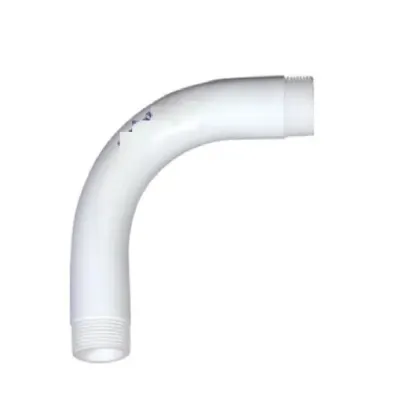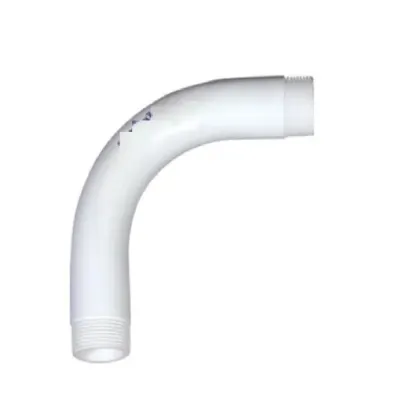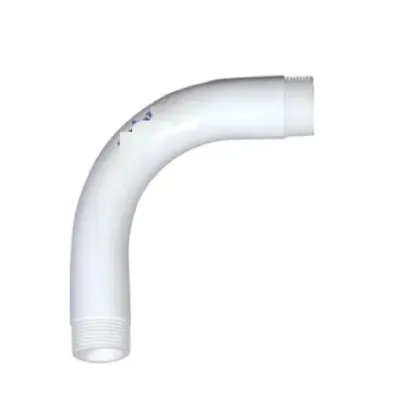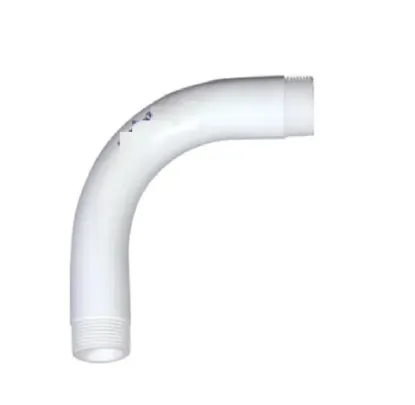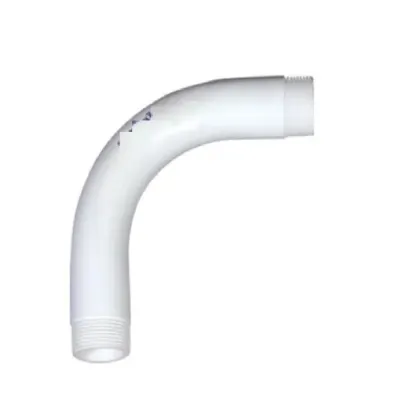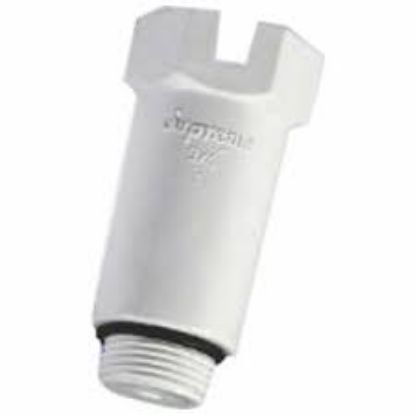Reachable at 9560662883  011-46039993 (Ext. 21 to 32) (10am - 06pm)
011-46039993 (Ext. 21 to 32) (10am - 06pm)
You have no items in your shopping cart.
Filter BY BRANDS
Plumbing
Buy Plumbing Tools
SUPREME AQUA GOLD , SACH - 80 ,BEND- 90 DEGREE THREADED ,SIZE- 25 MM
90 degree bends are used to connect two pieces of UPVC pipe that are at right angles to each other, with a sweeping bend in between. The advantage of a bend over a 90 degree PVC elbow is that there is less friction loss because the flow characteristics are so much better.
SUPREME AQUA GOLD , SACH - 80 ,BEND- 90 DEGREE THREADED ,SIZE- 32 MM
90 degree bends are used to connect two pieces of UPVC pipe that are at right angles to each other, with a sweeping bend in between. The advantage of a bend over a 90 degree PVC elbow is that there is less friction loss because the flow characteristics are so much better.
SUPREME AQUA GOLD , SACH - 80 ,BEND- 90 DEGREE THREADED ,SIZE- 40 MM
90 degree bends are used to connect two pieces of UPVC pipe that are at right angles to each other, with a sweeping bend in between. The advantage of a bend over a 90 degree PVC elbow is that there is less friction loss because the flow characteristics are so much better.
SUPREME AQUA GOLD , SACH - 80 ,BEND- 90 DEGREE THREADED ,SIZE- 50 MM
90 degree bends are used to connect two pieces of UPVC pipe that are at right angles to each other, with a sweeping bend in between. The advantage of a bend over a 90 degree PVC elbow is that there is less friction loss because the flow characteristics are so much better.
SUPREME AQUA GOLD , SACH - 80 ,BEND- 90 DEGREE THREADED ,SIZE- 65 MM
90 degree bends are used to connect two pieces of UPVC pipe that are at right angles to each other, with a sweeping bend in between. The advantage of a bend over a 90 degree PVC elbow is that there is less friction loss because the flow characteristics are so much better.
SUPREME AQUA GOLD , SACH - 80 ,BEND- 90 DEGREE THREADED ,SIZE- 80 MM
90 degree bends are used to connect two pieces of UPVC pipe that are at right angles to each other, with a sweeping bend in between. The advantage of a bend over a 90 degree PVC elbow is that there is less friction loss because the flow characteristics are so much better.
SUPREME AQUA GOLD , SACH - 80 ,BEND- 90 DEGREE THREADED ,SIZE- 100 MM
90 degree bends are used to connect two pieces of UPVC pipe that are at right angles to each other, with a sweeping bend in between. The advantage of a bend over a 90 degree PVC elbow is that there is less friction loss because the flow characteristics are so much better.
SUPREME AQUA GOLD , SACH - 80 ,BEND- 90 DEGREE THREADED ,SIZE- 100 MM
90 degree bends are used to connect two pieces of UPVC pipe that are at right angles to each other, with a sweeping bend in between. The advantage of a bend over a 90 degree PVC elbow is that there is less friction loss because the flow characteristics are so much better.
SUPREME, BY PASS BEND - 90 DEGREE SACH - 80 ,SIZE -20 MM
The Pass Over Bend is a transition fitting that allows a pipe to be "passed-over" without tearing apart the current plumbing system. This fitting aids in joining vertical pipes while avoiding the running lines' obstructing pipe.
SUPREME, BY PASS BEND - 90 DEGREE SACH - 80 ,SIZE - 25MM
The Pass Over Bend is a transition fitting that allows a pipe to be "passed-over" without tearing apart the current plumbing system. This fitting aids in joining vertical pipes while avoiding the running lines' obstructing pipe.
SUPREME, BY PASS BEND - 90 DEGREE SACH - 80 ,SIZE -32 MM
The Pass Over Bend is a transition fitting that allows a pipe to be "passed-over" without tearing apart the current plumbing system. This fitting aids in joining vertical pipes while avoiding the running lines' obstructing pipe.
SUPREME, BY PASS BEND - 90 DEGREE SACH - 80 ,SIZE -40 MM
The Pass Over Bend is a transition fitting that allows a pipe to be "passed-over" without tearing apart the current plumbing system. This fitting aids in joining vertical pipes while avoiding the running lines' obstructing pipe.
SUPREME, BY PASS BEND - 90 DEGREE SACH - 80 ,SIZE -50 MM
The Pass Over Bend is a transition fitting that allows a pipe to be "passed-over" without tearing apart the current plumbing system. This fitting aids in joining vertical pipes while avoiding the running lines' obstructing pipe.
SUPREME, OFFSET BEND ,SACH - 80, SIZE - 25 MM
The uPVC White Bottom Offset Bend from Flop last is required to finish soil and waste system installations. The Bend should be used in conjunction with the Flop last soil and waste system since it is dependable and simple to install.
SUPREME, OFFSET BEND ,SACH - 80, SIZE - 32MM
The uPVC White Bottom Offset Bend from Flop last is required to finish soil and waste system installations. The Bend should be used in conjunction with the Flop last soil and waste system since it is dependable and simple to install.
SUPREME, OFFSET BEND ,SACH - 80, SIZE - 20 MM
The uPVC White Bottom Offset Bend from Flop last is required to finish soil and waste system installations. The Bend should be used in conjunction with the Flop last soil and waste system since it is dependable and simple to install.
SUPREME CIRCUIT TESTING PLUG ,SIZE - 40 MM
A gadget called a circuit tester is plugged into an electrical outlet to check the wiring. A circuit tester features a number of lights that display the wire in the outlet's condition, enabling the technician to confirm that it was installed correctly.
SUPREME CIRCUIT TESTING PLUG ,SIZE - 50 MM
A gadget called a circuit tester is plugged into an electrical outlet to check the wiring. A circuit tester features a number of lights that display the wire in the outlet's condition, enabling the technician to confirm that it was installed correctly.
SUPREME CIRCUIT TESTING PLUG ,SIZE - 32 MM
A gadget called a circuit tester is plugged into an electrical outlet to check the wiring. A circuit tester features a number of lights that display the wire in the outlet's condition, enabling the technician to confirm that it was installed correctly.
SUPREME TANK CONNECTOR (SHORT ) SIZE - 100 MM
A form of tank fitting called a tank connector is also referred to as a tank inlet, tank outlet, or tank nipple. Due to its dependence on the water supply, this fitting must be leak-proof. Tank connectors come in numerous variants.

